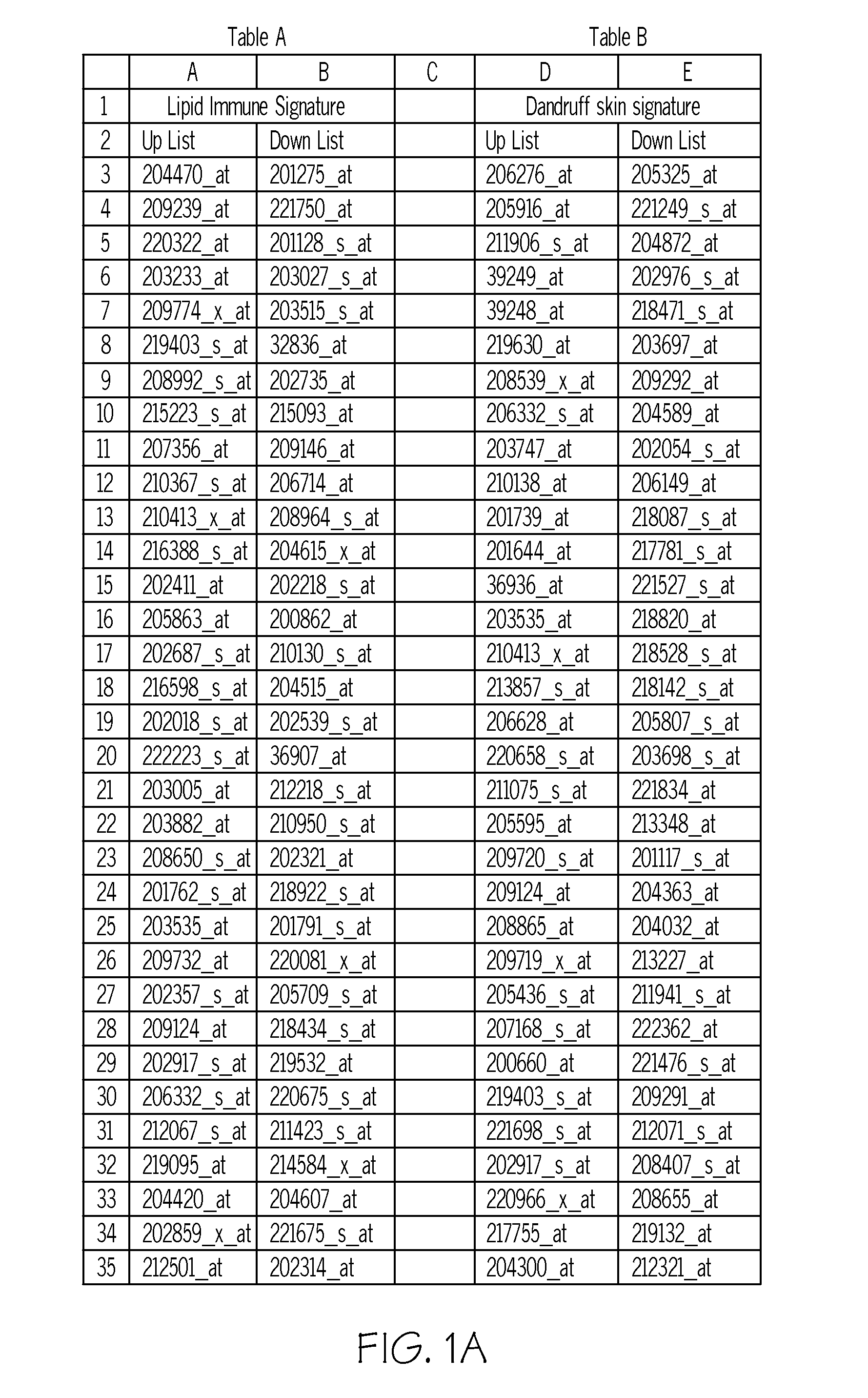Systems, Models and Methods for Identifying and Evaluating Skin-Active Agents Effective for Treating Dandruff/Seborrheic Dermatitis
a technology of skin-based active agents and skin-based diagnostic tests, applied in the field of systems, models and methods for identifying and evaluating skin-based active agents effective for treating dandruff/seborrheic dermatitis, can solve the problems of inability to diagnose dandruff, inability to accurately understand the underlying events that cause dandruff, and inability to accurately diagnose dandru
- Summary
- Abstract
- Description
- Claims
- Application Information
AI Technical Summary
Benefits of technology
Problems solved by technology
Method used
Image
Examples
example 1
Deriving a Dandruff Expression Signature
[0134]The samples were analyzed on the Affymetrix HG-U133 Plus 2.0 GeneChips, which contain 54,613 probe sets complementary to the transcripts of more than 20,000 genes. However, instances in the provided database used were derived from gene expression profiling experiments using Affymetrix HG-U133A 2.0 GeneChips, containing 22,214 probe sets, which are a subset of those present on the Plus 2.0 GeneChip. Therefore, in developing gene expression signatures from the clinical data, the probe sets were filtered for those included in the HG-U133A 2.0 gene chips.
[0135]A statistical analysis of the microarray data was performed to derive a plurality of dandruff gene expression signatures which may comprise a statistically relevant number of the up-regulated and down-regulated genes. In certain embodiments a dandruff gene expression signature includes between 10 and 400 up-regulated and / or between 10 and 400 down-regulated genes. In more specific embo...
example 2
[0143]This example illustrates that the complex dandruff condition may be represented by keratinocyte-based models and screening methods, and that gene expression profiles from keratinocytes and dandruff gene expression signatures can be used to reliably screen for candidate cosmetic agents for dandruff. The Example further illustrates the use of the gene expression profile to determine physiological thematic signatures useful for querying C-map to generate potential new skin-active agents and useful for screening skin active agents for anti-dandruff efficacy.
[0144]In accordance with methods of the invention, a broad gene expression profile for dandruff constituting the approximately 3,700 most-regulated genes was determined from comparing transcription data of dandruff-affected scalp skin to non-dandruff scalp skin. By analyzing the gene expression data in terms of Gene Ontology, a physiological theme profile is determined. This Example further illustrates that analysis of the Gene...
example 3
[0149]This Example illustrates validation of an In Vitro Model of the dandruff condition according to one embodiment of the present invention and the use of Thematic Signatures to guide the C-map query for skin-active agent candidate output.
[0150]Gene expression data from five inflammatory skin disorders (acne, atopic dermatitis, dandruff, eczema and psoriasis) were collected from a clinical genomics study and published studies. The raw expression data were used to produce a rank-ordered list of most differentially regulated genes associated with inflammatory skin disorders. This list was used to construct a gene signature for querying the provided database, the signature comprising the top 70 up-regulated and 70 down-regulated genes from the rank-ordered list.
[0151]The derived gene signature was used to query a provided database comprising gene expression data from clinical genomics studies of a widely different inflammatory skin disorders, published in vitro genomics studies of di...
PUM
| Property | Measurement | Unit |
|---|---|---|
| Fraction | aaaaa | aaaaa |
| Fraction | aaaaa | aaaaa |
| Biological properties | aaaaa | aaaaa |
Abstract
Description
Claims
Application Information
 Login to View More
Login to View More - R&D
- Intellectual Property
- Life Sciences
- Materials
- Tech Scout
- Unparalleled Data Quality
- Higher Quality Content
- 60% Fewer Hallucinations
Browse by: Latest US Patents, China's latest patents, Technical Efficacy Thesaurus, Application Domain, Technology Topic, Popular Technical Reports.
© 2025 PatSnap. All rights reserved.Legal|Privacy policy|Modern Slavery Act Transparency Statement|Sitemap|About US| Contact US: help@patsnap.com



